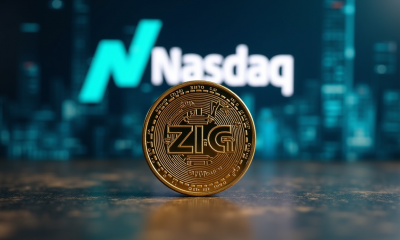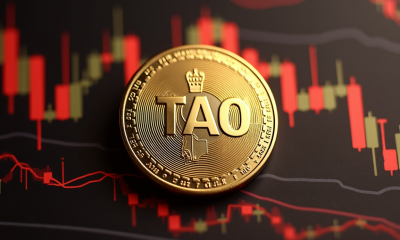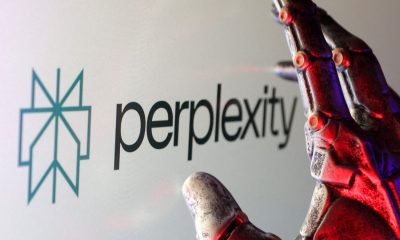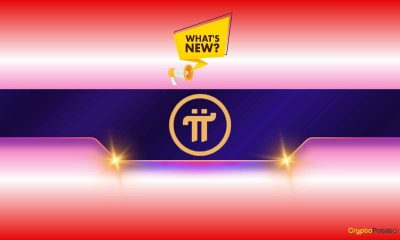

De-fi
Why Swiss and Hong Kong crypto regulations will lead the DeFi revolution – Crypto News
The following is a guest post from James Davies, CEO of Crypto Valley Exchange.
Regulators worldwide, international organizations, and market participants have published many consultation papers, recommendations, and opinions. The writers include groups like the Global Financial Markets Association, the Institute of International Finance, the International Swaps and Derivatives Association, the Futures Industry Association, the Financial Services Forum, and IOSCO (International Organization of Securities Commissions).
All major players from Coinbase to Circle are publishing responses to the regulatory framework and legislative drafting worldwide.
All of this is brought together in an IOSCO paper, “Policy Recommendations for Crypto and Digital Asset Markets,” which, rather unbelievably, doesn’t mention permissionless protocols once and only decentralized in passing.
I pity the regulator that bases its crypto policy development on this publication. Separately, IOSCO published a “Policy Recommendation for Decentralized Finance,” which combines their analysis with the Financial Stability Board (FSB) report “The Financial Stability Risks of Decentralised Finance.”
However, and this is a major criticism, the papers miss the core idea of decentralized projects. Trying to succinctly explain where they are wrong and what they can do to shift the perspective takes more input from insiders. The essential goal of decentralized projects is “to create the project features as the result of emergent behaviors through the actions of unrelated and replaceable actors.”
These effects are emergent, making decentralized projects so difficult to regulate. The report makes some reasonable insights, such as run-risk on assets from liquidity mismatch, such as the events that collapsed TerraUSD/Luna, and the roll-forward of this hitting Celsius very reminiscent of the events in 2008, the “collateral chain” risk.
Notably, traditional finance regulators still do not cover this well, where banning new activities dominates integration and understanding.
It also makes valuable points on cross-border regulatory arbitrage; however, this is where it demonstrates very precisely that it doesn’t understand DeFi. These structures make identifying appropriate legal ownership/control and relevant legal authorities difficult. It presupposes that there is a legal ownership and control point, the antithesis of decentralization.
This doesn’t mean that there aren’t some DeFi entities that do have these, and while running via smart contracts on-chain are not more like centralized entities, these, though, will get picked up in the core of the rest of the crypto regulation.
IOSCO doubles down on these misapprehensions about how decentralization works in some of their recommendations to regulators, especially the recommendation to identify responsible persons. Comments suggesting layer-1 blockchains might be considered clearing and settlement operations feel bizarre.
Other areas to look at include leverage, lending pool structures, tokenization, pseudonymous information, reporting, IP, and off-chain/on-chain touchpoints. Continued adoption and growth are undoubted and will have major impacts on world economies and traditional finance over time.
Most notably, every respondent to IOSCO, that is, every major regulator, when asked to provide an overview of current regulatory treatment, stated that they do not have separate regulatory frameworks specially dedicated to DeFi activities. They further note that whilst respondents state that they have regulation for crypto underway, they are not specifically targeting DeFi. Respondents also express their views that existing frameworks can apply to DeFi protocols.
Like social scientists everywhere, the Bank of International Settlement also seeks to understand the DeFi landscape. Their process is being examined through the lens of categorizing DeFi. While they appear to do an adequate job in this respect, it comes across in the conventional manner of treating each project as a standalone company.
To summarize the areas of concern from IOSCO:
- Conflicts of interest arising from vertical integration of activities and functions
- Market manipulation, insider trading, and fraud
- Cross-borderrRisks and regulatory cooperation
- Custody and client asset protection
- Operational and technological risk
- Retail access, suitability, and distribution.
How should regulators look at DeFi?
Rigid classification-based regulation has led to many unintended consequences; Sarbanes-Oxley requirements drove companies away from public markets. The subprime mortgage crisis resulted from a focus on individual loans and not their aggregation. The initial responses to the rise of the Internet and digital business were slow and reactive. By the time regulations arrived, companies already had established practices. Uber and Airbnb’s growth was restricted by a patchwork of local regulations that didn’t support these business models.
Urban planners misunderstood the effect of adding roads, leading to more traffic issues rather than less. The climate models debate focuses on specifics rather than the emergent effects, clouding the issues.
Regulators should start with governance structures, not individual properties. DAOs typically have a presence of some form, such as an organization with a corporate identity, often because a Labs entity needs something to hold the equity to pay real-world bills.
These entities, though, are often controlled entirely through the DAO. Requiring DAO registration and setting up specific corporate entity types that match how they operate would add value. Setting transparency, reporting, voting, staking, delegation, and control rules would remove the ambiguity on how to operate. Weed out abusive entities that want to rug pull and encourage entities that want to operate in a decentralized manner genuinely.
There can be many further developments related to operation style, such as requiring those that border otherwise regulated activities to have the appointed people selected by the DAO to face future regulatory developments in these areas. However, engaging and setting a framework for DAO establishment would be a good start.
A second area for examination would be about mutual recognition, currently regulation is fragmented, in some areas such as derivatives markets mutual recognition works well, in payments and crypto it acts as a barrier to growth creating a difficult patchwork of regulation. If DAO regulation were recognized between major regulators, then regulating in one country would enable access to other countries, a major incentive to projects to choose a grown-up location for their DAO, a good indicator to users of the intent of those involved in the project.
More thought needs to be given to dealing with emergent properties related to aspects such as clearing and settlement. There are compelling reasons why these should exist. For a start, trading on-chain assets supported by on-chain collateral causes real issues for existing traditional finance aspects. We all want to support this tokenization and transparency push, but this doesn’t come without traditional finance equivalents. This is about the disintermediation of existing power bases and control and the empowerment of new economy models, but friction in these systems needs to drop to establish. It is almost the precise point of free markets.
Ethical behavior, transparency, and clarity at the top of the list, along with DAO registration and support, can begin this. Regulators will need to become much more educated in the mechanics of these protocols and their operations to ensure they slowly build the right regulation, not just restrictive regulation.
How Switzerland and Hong Kong have gotten right what the US gets wrong
The crypto industry is still largely in its infancy, and regulators are still figuring out how to oversee its various aspects, but not all efforts are equal.
Once a beacon of innovation, the US has become a challenging jurisdiction for crypto finance projects, let alone decentralized versions. It is well documented how the country’s relatively strong anti-crypto stance and enforcement-heavy approach has stifled growth, driving founders to seek more welcoming environments.
Meanwhile, Switzerland and Hong Kong have crafted regulatory frameworks that accommodate crypto and permissionless projects.
The Swiss Financial Market Supervisory Authority (FINMA) doesn’t regulate protocols based in Switzerland if the activities conducted on the protocol result from the actions of actors based outside Switzerland. They are accessible, transparent, and engaging. Self-regulatory approaches, in general, are well supported.
The Securities and Futures Commission (SFC) of Hong Kong assesses each Defi project on a case-by-case basis, balancing a “same business, same risk, same rules” approach for crypto in general with a more nuanced position on permissionless protocols. At the same time, the US Securities and Exchange Commission (SEC) has confused and caused the US to fall behind the pack.
The EU is focused on examining everything through a payments lens, and the UK talks a better game than it implements. By embracing crypto’s unique needs and fostering a culture of entrepreneurship, these jurisdictions have become the go-to destinations for crypto companies seeking regulatory clarity and freedom to experiment. They are likely to do the same with DeFi.
As DeFi continues to evolve and transform the financial landscape, the role of regulatory frameworks becomes crucial in shaping its trajectory. With digital assets gaining momentum, tokenization under discussion, and traditional finance entering the space, the quest for regulatory environments that not only accommodate but also nurture DeFi is intensifying more even than just centralized crypto entities.
Navigating the DeFi Regulatory Landscape
With the current hot crypto market and lots of capital flowing into projects, the number of projects establishing DAOs over the next 18 months will be huge.
From a regulatory perspective, it’s time for them to set out their intent for these entities and the services that will be possible through these protocols.
Regarding the regulatory landscape for current DeFi projects, we see why more and more industry professionals feel drawn toward Switzerland’s approach. While the EU’s MiCA Regulation offers a comprehensive, harmonized framework with detailed rules for consumer protection and market integrity – appealing for projects seeking a uniform environment for cross-border European operations – Switzerland’s principle-based approach, flexibility is more compelling for projects not focussed on payment services. Not every project fits neatly into a one-size-fits-all mold; Switzerland seems to understand that.
Switzerland’s willingness to foster a supportive ecosystem, exemplified by Crypto Valley in Zug, is remarkable. Being part of a vibrant community with access to capital and opportunities for experimentation and growth is a crypto native’s dream.
Switzerland’s regulatory philosophy and pro-business stance make it particularly appealing. Innovative projects will have a better opportunity, be more likely to get regulatory clarity early and emerge from this thriving ecosystem, pushing DeFi boundaries and shaping finance’s future evolution. Switzerland’s approach resonates persuasively.
Hong Kong: A Financial Renaissance
Hong Kong is redefining its role as a crypto hub by implementing its new Virtual Asset Service Provider (VASP) regime. This regulatory framework introduces a structured yet dynamic environment that supports crypto innovation while maintaining robust safeguards.
The comprehensive VASP licensing ensures crypto platforms meet stringent criteria for liquidity, customer protection, and cybersecurity, fostering a balanced approach to regulation and innovation. By permitting retail trading of cryptocurrencies, Hong Kong nurtures a vibrant ecosystem that attracts retail investors while upholding necessary safeguards. It has yet to develop Defi specific regulation, we can only encourage to look at this holistically, developing DAO regulation first, but the approach to the rest lends confidence that this is a good location for businesses to establish whilst we wait.
Regulatory routes forward
Countries mustn’t follow in the footsteps of those who have failed to innovate in this field. The US, for instance, has been slow to adapt to the changing financial landscape, with regulatory uncertainty stifling growth and innovation. Meanwhile, US companies keep demanding clarity on regulation, with giants like Coinbase and their legal team demanding the SEC engage in rulemaking. Similarly, countries like Japan and South Korea have struggled to integrate crypto into their traditional financial systems, leading to a lack of progress.
Countries, including the US, must divide and approach centralized and decentralized activities differently. Some decentralized activities, such as market rate set risk, have many risks that could be prevented fairly easily under the right approvals regime. We know this will come and squeeze some major players, but early transparency on the direction will save the industry a lot of costs.
Currently, we look to countries like Switzerland and Hong Kong, which have taken a proactive approach to crypto, to lead in creating a supportive regulatory environment that will foster innovation and growth in Defi. By learning from their example, other countries can catch up and move forward rapidly.
While the future of decentralized tech watches the American Dream turns into a coma, Swiss developers are pouring Aperol and planning their ski trips.
-

 others1 week ago
others1 week agoMETA stock has lower gaps to fill – Crypto News
-

 Cryptocurrency5 days ago
Cryptocurrency5 days agoAndrew Tate Buys $5 Million Worth of Bitcoin Hours Before Crash – Crypto News
-

 Cryptocurrency5 days ago
Cryptocurrency5 days agoBitcoin tests $100K support after massive liquidation event rocks market – Crypto News
-

 Cryptocurrency4 days ago
Cryptocurrency4 days agoMany Crypto Treasury Companies Were a Get-Rich-Quick Trap, Warns Columbia Professor – Crypto News
-
Cryptocurrency1 week ago
After 1,993% Burn Spike, Is Shiba Inu Price Set for a Major Trend Reversal? – Crypto News
-

 Metaverse1 week ago
Metaverse1 week agoAI boom is just beginning – Nvidia CEO Jensen Huang explains what’s driving the virtuous cycle – Crypto News
-

 Cryptocurrency1 week ago
Cryptocurrency1 week agoZIGChain eyes gains as Nasdaq-Listed SEGG Media backs ZIG – Crypto News
-

 Cryptocurrency5 days ago
Cryptocurrency5 days agoAndrew Tate Buys $5 Million Worth of Bitcoin Hours Before Crash – Crypto News
-

 Cryptocurrency4 days ago
Cryptocurrency4 days agoStrategy IPO redefines corporate Bitcoin strategy with euro-denominated offering – Crypto News
-

 Blockchain1 week ago
Blockchain1 week agoSmart Money Buys the Dip – Crypto News
-

 Cryptocurrency5 days ago
Cryptocurrency5 days agoLitecoin: $855K ETF inflow sparks new life – Next target is $105 IF… – Crypto News
-
others6 days ago
“Never Had Plans to Sue Binance,” Wintermute CEO Evgeny Gaevoy Confirms – Crypto News
-

 Cryptocurrency5 days ago
Cryptocurrency5 days agoBittensor (TAO) plunges 16% amid broader crypto sell-off – Crypto News
-
Business1 week ago
Not L1s or Wallets – Who Generates the Bulk of Crypto’s $20B in Revenue? – Crypto News
-

 Blockchain1 week ago
Blockchain1 week agoBasel Reportedly Aims for Friendlier Crypto Bank Guidelines – Crypto News
-

 Cryptocurrency1 week ago
Cryptocurrency1 week agoHBAR under pressure, Descending channel hints at 24% downside move – Crypto News
-

 Cryptocurrency6 days ago
Cryptocurrency6 days agoRipple Just Made XRP and RLUSD Tradeable Like Stocks: Here’s How – Crypto News
-

 Blockchain6 days ago
Blockchain6 days agoStablecoin Orchestration Becomes FinTech Battleground – Crypto News
-

 Blockchain1 week ago
Blockchain1 week agoXRP Chart Mirrors Gold Right Before Its Parabolic Run – Crypto News
-

 others1 week ago
others1 week agoGBP/USD tests six months lows as Pound Sterling continues to sink – Crypto News
-
Technology1 week ago
XRP Price Outlook as ETF Nears Possible November 13 Launch – Crypto News
-

 Cryptocurrency1 week ago
Cryptocurrency1 week agoIs the Market Finally Learning to Handle Volatility? – Crypto News
-
others1 week ago
Russia S&P Global Manufacturing PMI dipped from previous 48.2 to 48 in October – Crypto News
-

 Metaverse1 week ago
Metaverse1 week agoPerplexity AI CEO Aravind Srinivas touts new feature revealing Indian politicians’ stock holdings—How will it work? – Crypto News
-
others1 week ago
Pi Coin Price Prediction After AI Investment Announcement – Is a Bull Run Ahead? – Crypto News
-

 Blockchain1 week ago
Blockchain1 week agoChainlink Maintains Its Base, But One Push Could Flip Sentiment Fast – Crypto News
-

 Blockchain6 days ago
Blockchain6 days agoTokenized Treasuries cross $8.6B as banks and exchanges push collateral use – Crypto News
-

 Cryptocurrency1 week ago
Cryptocurrency1 week agoOndo Finance launches 100+ tokenized assets on BSC – Here’s why it matters – Crypto News
-

 De-fi1 week ago
De-fi1 week agoFourMeme Surpasses Pumpfun With $43 Million in Monthly Revenue – Crypto News
-

 Technology1 week ago
Technology1 week agoGHOST extends rally as whale scoops 4.8 million tokens – Crypto News
-

 Technology1 week ago
Technology1 week agoCities Deploy Robots as Firefighters, Tour Guides and Lawnmowers – Crypto News
-

 others1 week ago
others1 week agoGBP/USD hits seven-month low as UK fiscal woes, Fed hawkishness weigh – Crypto News
-

 Blockchain1 week ago
Blockchain1 week agoBitcoin In IPO Phase As Early Holders Give Way to New Investors – Crypto News
-
Cryptocurrency6 days ago
Crypto Market Crash as $595.8M in Longs is Liquidated, Bitcoin Slides to $105,000 – Crypto News
-

 Cryptocurrency5 days ago
Cryptocurrency5 days agoGold declined but still outperformed BTC last week – Crypto News
-

 Cryptocurrency5 days ago
Cryptocurrency5 days agoPi Network (PI) News Today: November 4th – Crypto News
-

 Blockchain5 days ago
Blockchain5 days agoChainalysis Warns of ‘Concerning’ Vulnerabilities in DeFi Platforms – Crypto News
-
others5 days ago
AI Bubble: Big Short Legend Michael Burry Bets Against AI Giants As NVIDIA And Palantir Stocks Dip – Crypto News
-
Cryptocurrency5 days ago
Dogecoin Price Risks 20% Crash as Death Cross Aligns With Falling DOGE ETF Inflows – Crypto News
-

 Metaverse4 days ago
Metaverse4 days agoPaytm is getting AI! Vijay Shekhar Sharma drops cryptic teaser ahead of launch – Crypto News
-
Technology1 week ago
Pepe Coin Price Forms Multi-Year H&S Pattern as Whale Selling Intensifies – Crypto News
-

 Blockchain1 week ago
Blockchain1 week agoQuantum Computing Still Years from Threatening Bitcoin, Says VC Amit Mehra – Crypto News
-

 Metaverse1 week ago
Metaverse1 week agoGo from idea to app in minutes with Google AI Studio – Crypto News
-
Technology1 week ago
Why Is TAO Price Skyrocketing Today? – Crypto News
-

 Metaverse1 week ago
Metaverse1 week agoDoes Nvidia’s $5-trillion feat raise the spectre of an AI winter? – Crypto News
-

 Blockchain1 week ago
Blockchain1 week agoWill Bitcoin’s Latest Sunday Pump be Different This Time? – Crypto News
-

 Blockchain1 week ago
Blockchain1 week agoHow To Price XRP? Ripple CTO Says The Ledger Isn’t The Answer – Crypto News
-
Business1 week ago
Breaking: Coinbase Nears $2B Deal to Buy Stablecoin Platform BVNK – Crypto News
-

 Cryptocurrency1 week ago
Cryptocurrency1 week agoTaiwan Index Today: Live Chart, Historical Performance, and Market Analysis – Crypto News
-

 De-fi1 week ago
De-fi1 week agoHow Avalanche is Tackling the Blockchain Trilemma – Crypto News


















